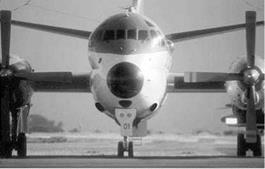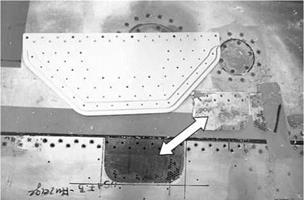The following case illustrates the influence of a maritime climate and the classic pattern of bond-line corrosion (see Section 7.7.6). The aircraft concerned had been used for low-altitude maritime surveillance for about 40 years, and were therefore exposed to severe aerodynamic and corrosive conditions.
Both, the cabin and the wings are mostly made of bonded honeycomb structures, but when these aircraft were manufactured pickling, rather than anodization, was the typical surface preparation for aluminum adherents (AA 2024 T3) (see Section 8.2). The adhesive used was an epoxy resin adhesive for aircraft. Despite 40 years’ of operation and loading, and the use of an inadequate surface preparation leading (from today’s perspective) to poor resistance to corrosion and aging, the bonds were in a good condition. The only critical component was the heavily loaded center wing box, that carries and interconnects the engine, the cabin and the outboard wing (Figure 7.66).
As is typical for bond-line corrosion, adhesive failure started at the damaged areas of riveted joints and boreholes, and large-area delamination of the adhesive joint ensued. In such cases, delaminations are usually detected by means of ultrasound. The structure may then be opened, the corroded skin area removed and the area then
|
|
|
Figure 7.66 Bond-line corrosion in a sandwich. |
re-bonded, with a second new outer skin sheet being additionally applied by bonding or riveting. As bond-line corrosion is a well-known risk, it is important to ensure a reliable sealing of the riveted joints and seams during maintenance and repair. Moisture and sea atmosphere must reliably be prevented from penetrating the bond and initiating bond-line corrosion and eventual failure.
The repair of corroded parts is standard for maintenance programs, and many years of experience have been acquired in this respect. Therefore, a sudden and striking increase in the corrosion damage of bonded joints attracted much attention. At first, the increase was assumed to be due to the age of the aircraft and suboptimal surface preparation. As a solution to the problem — and to prevent further damage — improved sealing measures were considered. When this was attempted, however, it was found that several years earlier, due to the introduction of environmental protection and occupational safety regulations, a change to chromate-free sealants was made such that anticorrosive chromated primers were no longer used. By doing this, a reliable corrosion protection system was eliminated, without taking into account its critical importance to the long-term performance of adhesive bonds and the structural integrity of the aircraft.
7.8.4
 1 ноября, 2015
1 ноября, 2015  Pokraskin
Pokraskin 

 Опубликовано в рубрике
Опубликовано в рубрике 